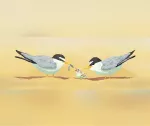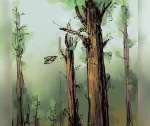
Aiden Chen, 15 year old student, artist and Loma Prieta Chapter volunteer, has a passion for birds and worries about their welfare as sea levels rise due to the progressive impacts of climate change. Aiden has found a fun way to expand his volunteer contributions and raise awareness around sea level rise impacts on birds and wildlife, through this awareness through artwork series. He has been drawing and painting San Francisco Bay shoreline birds and wildlife in their natural, wild habitats and is writing fun facts or quiz questions to accompany his artwork.
Sierra Club's Bay Alive and 30x30 campaigns promote the use of nature based solutions to protect the San Francisco Bay wetlands, associated habitats, and human communities from sea level rise. The 30x30 campaign works to conserve 30% of California’s lands and waters by 2030.

Burrowing Owl
Burrowing owl nests are underground and face flooding from sea level rise. Compounded with increasing urban development, burrowing owls’ habitats along the bay are rapidly declining.

Black Skimmer
Nests made by skimmers are on beaches and are vulnerable to flooding from sea level rise. Areas that skimmers settle in tend to also be frequented by humans, who trample and destroy nests.
Ridgway's Rail
The Ridgway’s rail depends significantly on marsh habitats for survival. With the flooding of these marshes from sea level rise, the rails are pushed out from safety and face increased vulnerability to predators, which are the direct leading cause of mortality for the Ridgway’s rail.
Snowy Plover
The Western Snowy Plover is a threatened shorebird species with populations that nest on the beaches of California’s Pacific Coast. Because they rely on safe beaches, increased disturbances by humans and human-introduced predators have done increasing damage to their populations. With sea level rise encroaching on beaches as well, Snowy Plovers come into even further contact with disruptions to their nesting. As a result, Snowy Plovers have also taken up salt flats as alternative nesting sites.

California Least Terns
The California Least Terns are an endangered migratory seabird species that nest in colonies on the ground along parts of the coast of California. They rely heavily on open, sandy dune habitats both for nesting and for the anchovies and smelt in nearby waters for food. Increasing human disturbances, like development and beachgoers, along with other sources of habitat loss, like sea level rise, forces the terns to nest in urban environments and in concentrated areas so that access to food would be preserved. This, in turn, makes them very vulnerable to predation by threats ranging from feral cats to crows to raccoons. An example would be the tarmac at the closed Alameda Naval Air Station, which supports a successful colony but must be managed annually by the USFWS and its volunteers to limit urban predators.

Marbled Murrelet
The Marbled Murrelet is a threatened seabird species that lives off the western coast of the US. They, like the typical seabird, feed from the ocean, but where they begin to differ is their unique behavior of nesting high up on the branches of trees in mature and old growth forests. However, extensive logging and development have destroyed vast areas of their nesting grounds. Such destruction also means fragmentation of forests, increasing their exposure to predators. In addition, their shoreline feeding behavior makes them reliant on the health of oceans.
California Brown Pelican
The California Brown Pelican is a seabird that lives off the California Coast with a remarkable conservation history. Like the Bald Eagle, it too suffered from DDT pollution. However, it too made a massive comeback, eventually being removed from the Endangered species list while retaining monitoring and some protections. Although their populations are much healthier now, these pelicans still face dangers from other types of pollution and to the variability of fish populations they rely on. In addition, sensitivity to human activity means encroachment and development are once again threats that must be considered as well. The California Brown Pelican flips a fish when eating so that the spines don’t snag on its pouch as it gets swallowed.

Willet
Shown above is the Willet exhibiting the phenomena of male birds watching the nest at night instead of females. Willets are a shorebird species with two distinct populations: the Western Willets, inland breeders that winter on coasts, and Eastern Willets, coastal breeders that winter in the south of the US. The Western Willet population is forecasted by California Audubon to lose 70% of its wintering range by 2080. Willets have lost native grassland to agricultural conversion while also losing coastal wintering sites and wetlands to urban development and sea level rise.


